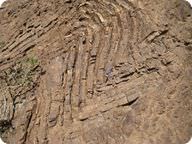6.1地质应力
章节大纲
-
When people have too much stress they may break. What happens if a rock gets too much stress?
::当人们承受太多压力时,他们可能会崩溃。如果岩石承受太多压力,会怎样?Lithospheric plates do a lot of moving on Earth's surface. Slabs of lithosphere smash into each other. They move sideways past each other along . Where conditions are right, magma rises through solid . It's no wonder that rocks experience stress! Rocks respond differently to different types of stress and under different conditions.
::地平层板块经常在地球表面移动。 地平层板块互相碰撞。 它们会绕着彼此移动。 在条件正确的地方, 岩浆会通过固体而上升。 怪不得岩石会承受压力! 岩石对不同类型的压力和不同条件的反应不同。Types of Stress
::压力类型Stress is the force applied to a rock. Plates experience stress when they collide, move apart, or slide past each other. Plates moving on a rounded surface experience stress. Stress happens to rocks on a smaller scale, too. Local movements can cause stress in rocks.
::压力是对岩石施加的力力。 平板在相撞、 分离或滑过对方时经历压力。 平板在四舍五入的地表上移动。 岩石也会受到较小的压力。 局部运动可能会在岩石中造成压力。There are four types of stresses that affect rocks:
::影响岩石的重力有四种类型:- Confining stress comes from the weight of all the overlying rock. This weight pushes down on a deeply buried rock. The rock is being pushed in from all sides, which compresses it. The rock will not deform because there is no place for it to move.
::封闭的压力来自所有上覆岩石的重量。 重力压到深埋的岩石上。 岩石被从四面挤进去, 压住它。 岩石不会变形, 因为没有地方可以移动。
- Compression stress squeezes rocks together. Compression causes rocks to fold or fracture ( Figure ). When two cars collide, compression causes them to crumple. Compression is the most common stress at convergent plate boundaries .
::压缩压力将岩石挤在一起。 压缩导致岩石折叠或骨折( 图表 ) 。 当两辆汽车相撞时, 压缩导致它们折叠。 压缩是聚板边界上最常见的压力 。
Stress caused these rocks to fold.
::压力导致这些岩石折叠。- Tension stress pulls rocks apart. Tension causes rocks to lengthen or break apart. Tension is the major type of stress found at .
::紧张局势导致岩石长长或断裂。 紧张局势是主要的压力类型。
- Shear stress happens when forces slide past each other in opposite directions ( Figure ). This is the most common stress found at .
::当力向相反方向滑过时,就会出现剪裁压力。这是最常见的压力。
This rock has undergone shearing. The pencil is pointing to a line. Stresses forced rock on either side of that line to go in opposite directions.
::铅笔指向一条线, 柱子迫使线的两侧的岩石向相反的方向移动。Responses to Stress
::对压力反应的回应The amount of stress on a rock may be greater than the rock's strength. In that case, the rock will undergo strain or deformation ( Figure ). Deep within the Earth, the pressure is very great. A rock behaves like a stretched rubber band. When the stress stops, the rock goes back to its original shape. If more stress is applied to the rock, it bends and flows. It does not return to its original shape. Near the surface, if the stress continues, the rock will fracture (rupture) and break.
::岩石承受的压力可能大于岩石的强度。 在这种情况下, 岩石会受到压力或变形( 图表 ) 。 在地球深处, 压力非常大 。 岩石的行为举止像一个伸展的橡皮筋。 当压力停止时, 岩石会回到原来的形状。 如果对岩石施加更大的压力, 它会弯曲和流。 它不会回到原来的形状 。 如果压力继续下去, 岩石会断裂( 断裂) 。With increasing stress, the rock undergoes: (1) elastic deformation, (2) plastic deformation, and (3) fracture.
::随着压力的增加,岩石经历了1) 弹性变形,(2) 塑料变形,(3) 骨折。
Summary
::摘要- Stress is the force applied to an object. Stresses can be confining, compression, tension, or shear.
::压力是指对物体施加的力力。 压力可以是限制、压缩、紧张或剪切。
- Rocks under stress may show strain or deformation. Deformation can be elastic or plastic, or the rock may fracture.
::承受压力的岩石可能显示出压力或变形,变形可以是弹性的,也可以是塑料的,或者岩石可能骨折。
- Rocks respond to stress differently under different conditions.
::岩石在不同条件下对压力的反应不同。
Review
::回顾- What type of stress would you find at a transform fault?
::变形故障会有什么压力?
- What type of stress would you find at a subduction zone?
::你在潜入区会遇到什么样的压力?
- Under what conditions will a rock fracture?
::在什么条件下岩石会断裂?
- Confining stress comes from the weight of all the overlying rock. This weight pushes down on a deeply buried rock. The rock is being pushed in from all sides, which compresses it. The rock will not deform because there is no place for it to move.



